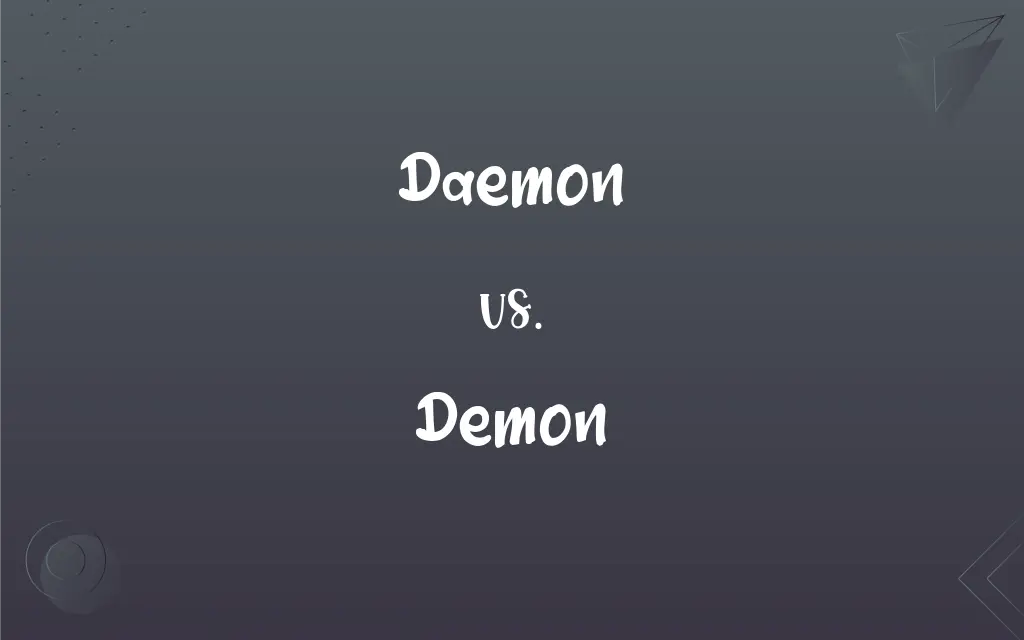Daemon vs. Demon: What's the Difference?
Edited by Aimie Carlson || By Janet White || Published on February 27, 2024
A daemon is a background process in computing, while a demon is a malevolent supernatural being.

Key Differences
A daemon, in computing, refers to a background process that handles tasks without user interaction. In contrast, a demon, often found in mythology and religion, is a malevolent supernatural entity believed to have harmful influence.
Daemons in computer systems are crucial for managing system operations, like logging, security checks, or scheduling tasks. Demons, however, are associated with evil and malevolence in cultural narratives and are often depicted in literature and media as causing harm or mischief.
The term daemon originated from a Greek word meaning 'divine power' but in computing, it represents a benign and helpful process. The word demon, deriving from the same Greek root, evolved to carry negative connotations in most Western religious and mythological contexts.
In the tech world, daemons are not visible to users but work silently in the background, enhancing user experience. In folklore and religious beliefs, demons are often depicted as visible and fearsome entities that interact with humans, usually in a harmful way.
Daemons are integral to the smooth functioning of computer systems, often running continuously from startup to shutdown. Demons, in stories and beliefs, are invoked or conjured through rituals and are not a constant presence in the human realm.
ADVERTISEMENT
Comparison Chart
Definition
A background process in computing
A malevolent supernatural being
Origin
Greek word for 'divine power', used in tech context
Greek root, evolved with negative connotations in Western culture
Role
Manages system operations silently
Causes harm or mischief in mythology
Visibility
Invisible to users, operates in background
Often depicted as visible, interacting with humans
Presence
Continuously running in systems
Invoked or conjured, not always present
ADVERTISEMENT
Daemon and Demon Definitions
Daemon
Daemon is a background process in a computer system.
The print spooler daemon manages all print jobs on the server.
Demon
Demon is a malevolent supernatural entity in various mythologies.
In folklore, the demon was blamed for unexplained misfortunes.
Daemon
Daemon is a non-interactive process in an operating system.
The network daemon handles various network services.
Demon
Demon is a spiritual being with harmful intentions.
Ancient stories often depict a hero battling a powerful demon.
Daemon
Daemon is a program that runs continuously without user intervention.
The email daemon on the server routes incoming and outgoing messages.
Demon
Demon is a figure in religious beliefs symbolizing evil.
The ritual was said to ward off evil demons.
Daemon
Daemon is a utility that performs system-level tasks in the background.
The system log daemon collects and stores system logs.
Demon
Demon is an embodiment of vice or malevolence in mythology.
The demon in the tale personified greed and envy.
Daemon
Daemon is an essential component of system management in computing.
The file system daemon organizes and manages file system operations.
Demon
Demon is a supernatural creature in cultural narratives and media.
The horror movie featured a demon haunting an old mansion.
Daemon
Chiefly British Variant of demon.
Demon
An evil supernatural being; a devil.
Daemon
Variant of daimon.
Demon
A persistently tormenting person, force, or passion
The demon of drug addiction.
FAQs
Do daemons interact with users directly?
No, they operate silently in the background.
What is a demon in mythology?
A malevolent supernatural being.
Are demons always depicted as evil?
Mostly, though some cultures have more nuanced views.
What is the cultural significance of demons?
They represent evil and malevolence in many beliefs.
What tasks do daemons perform in a computer?
System logging, security checks, task scheduling.
What's an example of a daemon in a computer?
The Apache web server daemon for hosting websites.
Can a daemon be manually controlled?
Yes, by system administrators.
What's a common portrayal of a demon in media?
A harmful entity causing fear or damage.
Can demons take physical form in stories?
Yes, they often have a physical, frightening form.
What is a daemon in computing?
A background process that handles tasks without user interaction.
Are daemons essential for computer operation?
Yes, they are crucial for many system functions.
Is a daemon visible to computer users?
No, it runs invisibly in the background.
Are demons part of religious teachings?
In many religions, yes, often symbolizing temptation or evil.
Do daemons require user input to function?
No, they operate autonomously.
What's the historical origin of demons?
They have roots in ancient religions and mythologies.
Can daemons affect computer performance?
They can, especially if not managed properly.
Are demons always supernatural?
Typically, in most narratives and beliefs.
Do demons have any positive aspects?
In some cultures, they can have complex roles beyond just evil.
How do daemons contribute to user experience?
By ensuring smooth system operations.
Can a demon be benevolent?
Rarely, but some folklore does have benevolent spirits labeled as demons.
About Author
Written by
Janet WhiteJanet White has been an esteemed writer and blogger for Difference Wiki. Holding a Master's degree in Science and Medical Journalism from the prestigious Boston University, she has consistently demonstrated her expertise and passion for her field. When she's not immersed in her work, Janet relishes her time exercising, delving into a good book, and cherishing moments with friends and family.
Edited by
Aimie CarlsonAimie Carlson, holding a master's degree in English literature, is a fervent English language enthusiast. She lends her writing talents to Difference Wiki, a prominent website that specializes in comparisons, offering readers insightful analyses that both captivate and inform.































































